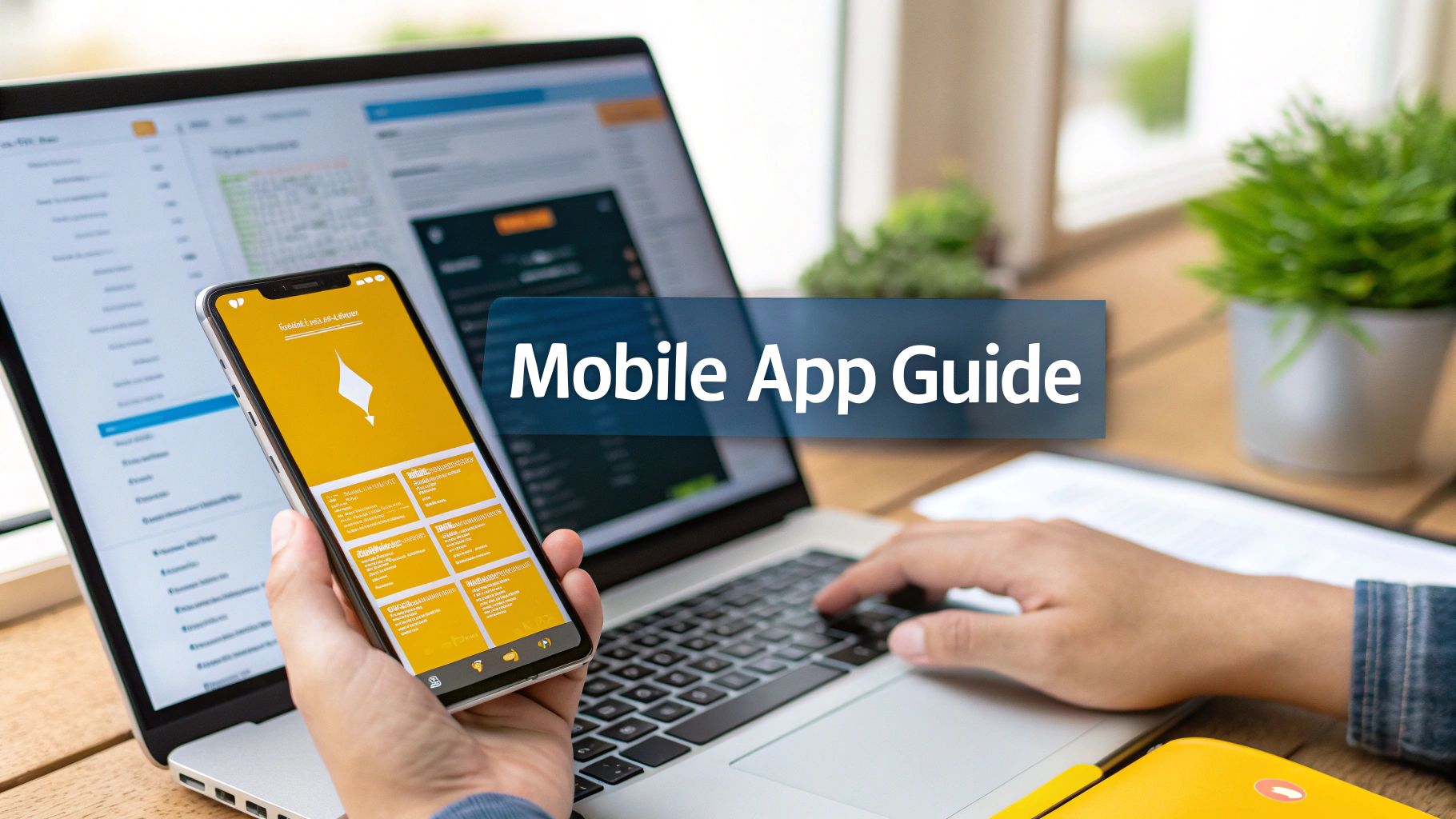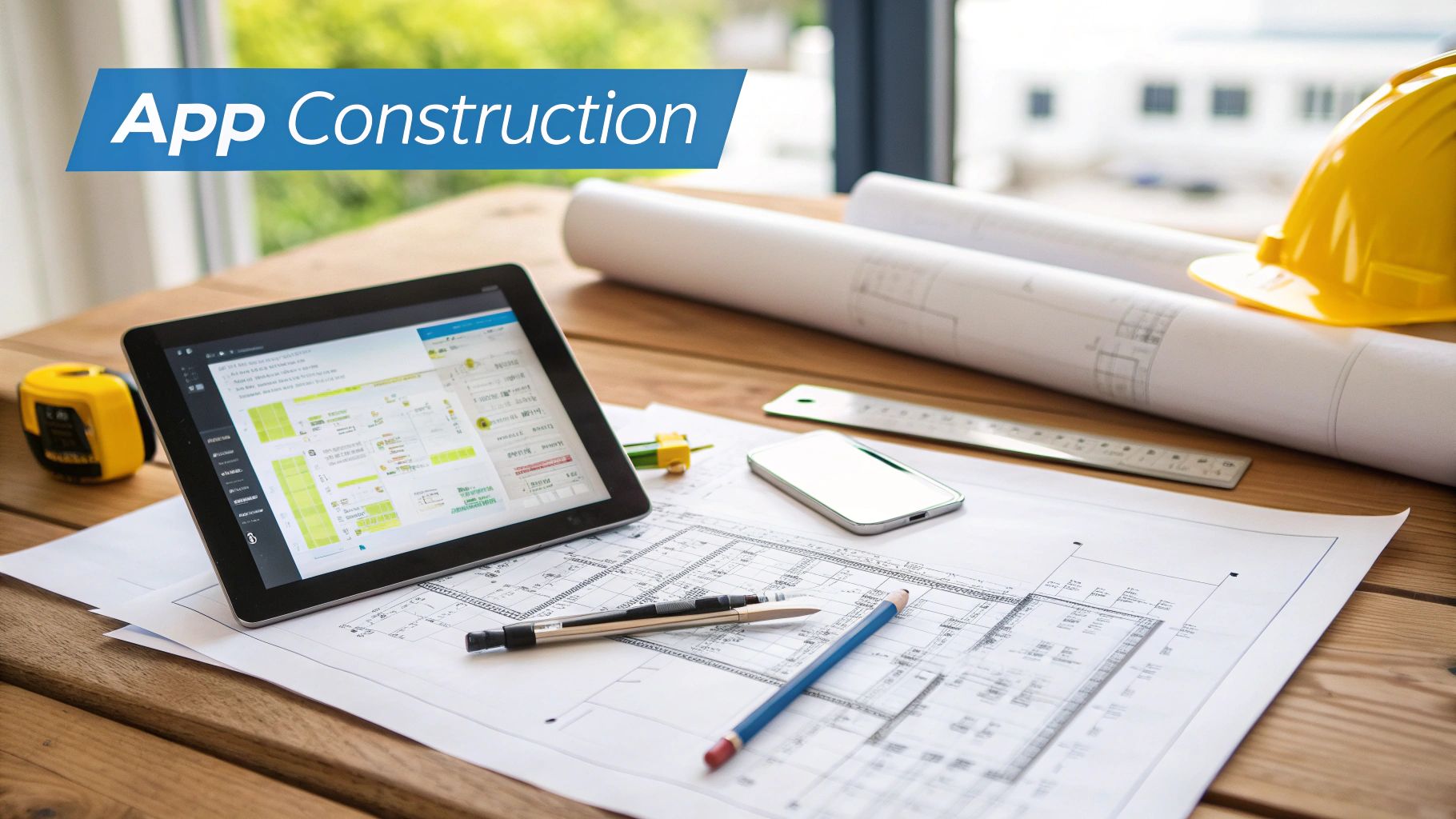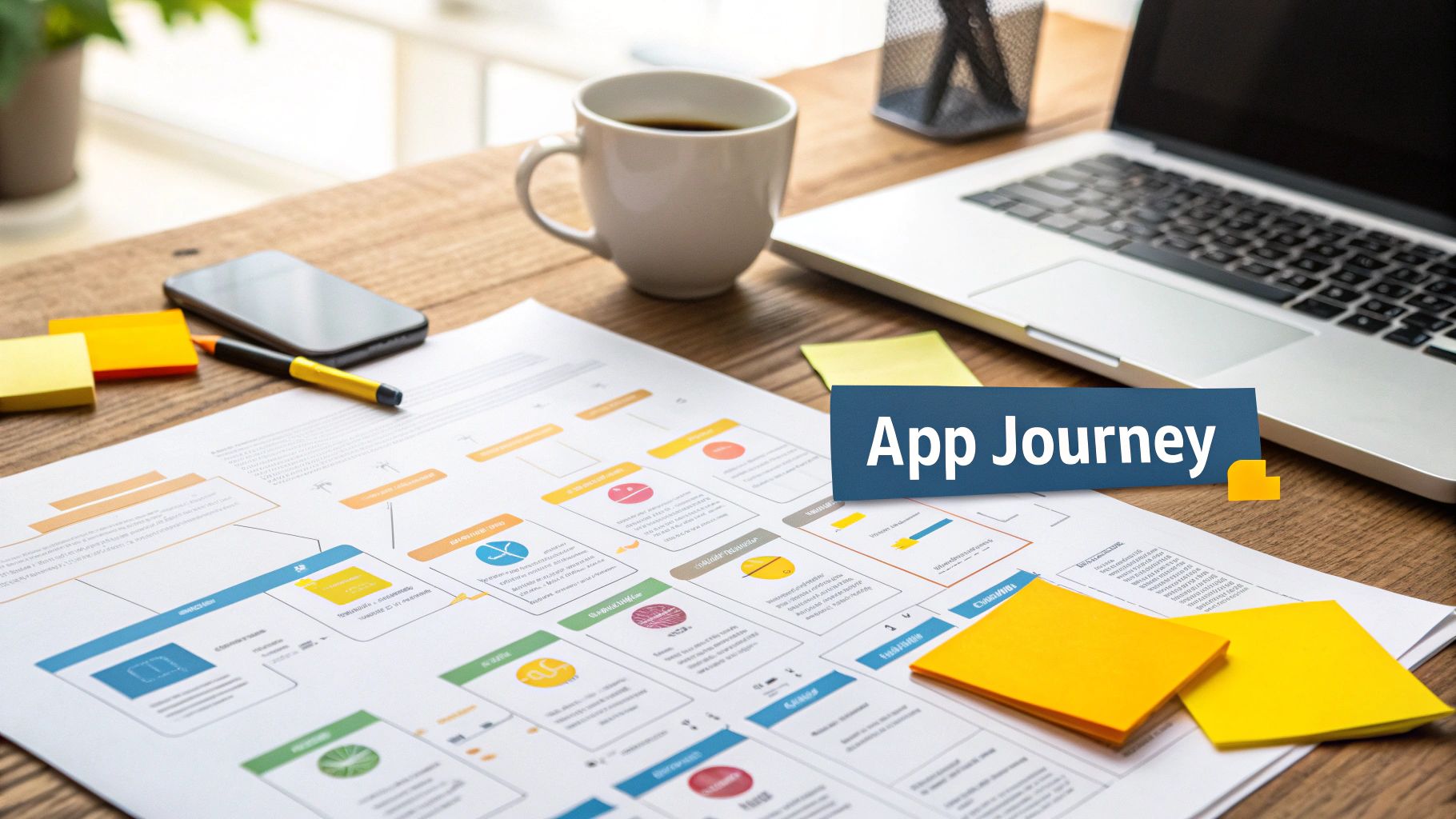Expert Mobile App Development Services Guide

When you hear "mobile app development services," what comes to mind? It's easy to just think of coders typing away in a dark room. But in reality, it's a comprehensive service that covers the entire journey of creating software for smartphones and tablets.
Think of it like building a custom home. You wouldn't just hire a bricklayer. You'd bring in a whole team—architects, project managers, electricians, plumbers, and interior designers—to bring your vision to life. Mobile app development services are the digital equivalent, handling everything from the initial blueprint to the post-launch handyman work.
What Are Mobile App Development Services

Signing on with a mobile app development service isn't just about hiring someone to write code. It's about forming a partnership to turn a concept into a real, market-ready product. It’s a holistic process where a bunch of different disciplines have to work together perfectly. This ensures your app isn't just a technical marvel but is also set up to actually succeed in a crowded marketplace.
A full-service provider acts like a general contractor for your digital project, managing every single stage. This all-inclusive approach typically involves:
- Strategy and Discovery: This is where it all begins. Who is this app for? What problem does it solve? Who are the competitors? This phase lays the foundation for everything that follows.
- UI/UX Design: Here, the team designs the user interface (UI) and user experience (UX). It’s all about making the app look great, feel intuitive, and be a genuine pleasure to use. Think of this as the architectural blueprint.
- Coding and Engineering: This is the construction phase. Developers get to work writing the code for both the front-end (what you see and tap on) and the back-end (the servers and databases that make it all work).
- Quality Assurance (QA) and Testing: Before anyone gets their hands on it, the app is put through its paces. Testers hunt down bugs, check for performance issues, and poke at it to find security holes.
- Deployment and Launch: Finally, the team handles the often-tricky process of submitting the app to the Apple App Store and Google Play Store.
Beyond the Initial Build
But the job isn't done when the app goes live. That’s really just the beginning. Just like a house needs maintenance, an app needs ongoing support to stay in good shape. This is a crucial piece of the puzzle.
The post-launch phase is where many businesses see the true value of a long-term development partner. It ensures the app remains compatible with new operating system updates, addresses user feedback, and evolves with new features over time.
This complete, end-to-end management is what really separates professional mobile app development services from just hiring a freelancer for a one-off task. Whether you need a full team to take the reins or just a few specialists to help your in-house staff, understanding this whole ecosystem is the first step. For those weighing their options, exploring different expert development agency services can help clarify which model makes the most sense for your project and budget.
How Should You Hire Your App Development Team?

Okay, you know what goes into building an app. The next big question is: who’s actually going to do the work? Choosing how you bring a development team on board isn't just a logistical detail—it fundamentally shapes your project's budget, timeline, and your own level of involvement.
Think of it less as a one-size-fits-all decision and more like figuring out the right way to assemble your crew. You wouldn’t hire a full construction company to fix a leaky faucet, right? Similarly, you wouldn't hire a single plumber to build a skyscraper. It’s all about matching the model to the mission.
Let's break down the three main ways you can engage app development services.
1. The Full-Service Agency
This is your all-in-one, "we'll handle it" option. Hiring a full-service agency is like bringing in a general contractor to build a house. You give them the blueprint and the vision, and they manage everything else—from the foundation and framing to the plumbing, electrical, and final coat of paint.
An agency brings a complete, pre-built team to the table: a project manager, UI/UX designers, multiple developers for different platforms, and quality assurance testers. This model is perfect for businesses that don't have an in-house tech team or want to hand off the entire complex process to a group of seasoned experts.
A full-service agency takes complete ownership of the project lifecycle. This is the best choice for complex projects or for companies that need end-to-end management without building an internal team from scratch.
2. Staff Augmentation
What if you already have a solid crew but just need a specialist? That’s where staff augmentation comes in. Think of it as extending your existing team. You might have a great in-house team of developers but lack a senior Android expert or a UX researcher with experience in your niche.
Staff augmentation lets you bring in individual professionals who integrate directly into your team, reporting to your project manager and working alongside your employees. This gives you incredible flexibility, allowing you to fill skill gaps or add extra hands during a critical project phase without the long-term commitment of a new hire. You maintain full control, you just get the targeted expertise you need, right when you need it.
For a deeper dive, our guide on staff augmentation versus outsourcing breaks down the nuances of integrating talent versus delegating entire projects.
3. Hiring Freelance Developers
The third route is to hire freelance developers directly from platforms like Upwork or Toptal. This is the most direct approach, similar to hiring an independent electrician to install a new light fixture. It’s perfect for small, clearly defined jobs.
Hiring a freelancer is often the most cost-effective option, and it gives you access to a massive global talent pool. However, the trade-off is that all the project management, quality control, and coordination fall squarely on your shoulders. This model works beautifully for building a simple prototype, adding a single new feature, or handling a specific task. But for a large, complex app, trying to juggle multiple freelancers can quickly become a full-time job in itself.
Comparing App Development Service Models
Choosing the right model is crucial for your project's success. This table breaks down the three approaches side-by-side to help you see which one aligns best with your goals, resources, and management style.
| Model | Best For | Pros | Cons |
|---|---|---|---|
| Full-Service Agency | Companies without a tech team, complex projects, and end-to-end needs. | A complete, expert team; single point of contact; full accountability; streamlined process. | Highest cost; less direct control over individual team members; can be a slower start. |
| Staff Augmentation | Businesses with an in-house team that needs to fill specific skill gaps. | Flexible and scalable; deep integration with your team; full project control; cost-effective. | Requires strong internal project management; you are responsible for the project's success. |
| Hiring Freelancers | Small, well-defined projects; specific tasks; or businesses on a tight budget. | Most affordable option; direct access to a huge talent pool; fast hiring for simple tasks. | You handle all management and quality control; risk of inconsistency; difficult to scale. |
Ultimately, there's no single "best" choice. The ideal model depends entirely on your project's complexity, your budget, and how hands-on you want to be. A startup with a simple MVP might thrive with a freelancer, while a large enterprise launching a flagship app will benefit from the comprehensive support of an agency.
Picking Your Platform: Native, Hybrid, or Web App?
Once you’ve figured out who will build your app, the next major fork in the road is deciding what to build it with. This isn't just a technical choice for the developers to geek out on; it’s a strategic decision that shapes your budget, timeline, user experience, and how you'll maintain the app down the road.
Think of it like choosing the right vehicle for a trip. A race car is perfect for a smooth track, but you wouldn't take it off-roading. You need the right tool for the job.
The mobile app world is a crowded and lucrative space. The global market is on track to blow past $1 trillion by 2034, and people already spend an average of 3.5 hours a day glued to their phones. This just goes to show how crucial it is to build something that not only works flawlessly but also gets in front of your audience where they live and breathe.
So, let's break down the three main paths you can take. Each has its own strengths and trade-offs.
The High-Performance Race Car: Native Apps
A native app is custom-built for one specific operating system—either iOS or Android. It's like a Formula 1 car, engineered from the ground up to dominate a single racetrack. It’s written in the platform's "native" language: Swift or Objective-C for Apple devices, and Kotlin or Java for Android.
This single-minded focus delivers incredible results. Native apps are the undisputed champions of performance and speed. They offer the smoothest user experience because they have direct, unrestricted access to the phone’s hardware—the camera, GPS, microphone, you name it. They also look and feel exactly right to users because they adhere strictly to the design conventions of iOS or Android.
So, what's the catch? You have to build and maintain two completely separate apps from two different codebases. That means double the work, double the cost, and a longer wait to get your app into users' hands.
Choose Native If:
- Performance is everything: Your app involves intense graphics, complex calculations, or needs to respond instantly.
- You need deep hardware access: The core of your app relies on using the phone's sensors, like the accelerometer or Bluetooth.
- The user experience must be flawless: You’re aiming for that silky-smooth, perfectly intuitive feel that users expect from their favorite apps.
The All-Terrain Vehicle: Hybrid Apps
What if you need to perform well on different terrains without buying a separate vehicle for each? That’s the idea behind hybrid apps. A hybrid app is like a versatile all-terrain vehicle—it’s built from a single codebase that runs on both iOS and Android.
Developers use powerful frameworks like React Native, Flutter, or Xamarin to write the code once and deploy it everywhere. This dramatically cuts down development time and cost, making it a fantastic option for businesses trying to reach the widest audience as quickly as possible.
Of course, there are trade-offs. While modern hybrid frameworks are incredibly capable, they sometimes can't quite match the raw speed and buttery feel of a true native app. Tapping into device hardware can occasionally be a bit more complex, and the UI might feel a tiny bit "off" to discerning users on either platform. For a deeper dive into this approach, check out our guide on mobile app cross-platform development.
Hybrid development strikes a powerful balance between cost, speed, and reach. For many applications, the performance difference is negligible to the end-user, making it the most practical choice for launching an MVP or serving a wide customer base.
The Universal Access Pass: Progressive Web Apps
Finally, we have an option that blurs the line between a website and an app: the Progressive Web App (PWA). The best way to think of a PWA is as a website on steroids, supercharged with app-like features. It runs in a browser but feels and acts a lot like a native app.
Users can find a PWA through a simple web search and use it instantly—no app store download required. They can even add an icon to their home screen, get push notifications, and access some features offline. This makes PWAs unbelievably easy to access and share.
The main limitation here is hardware access. PWAs can't dig as deep into a device's features as native or hybrid apps can. While they can use things like the camera and location, more advanced integrations are often off-limits. Performance can also become an issue for more demanding, feature-heavy applications.
Choose a PWA If:
- Maximum reach is your top priority: You want to eliminate every possible barrier between a user and your app.
- Your budget is tight: PWAs are typically the most cost-effective option to build and maintain.
- You want to skip the app store: Since PWAs live on the web, you don't have to deal with the lengthy and sometimes unpredictable approval processes of Apple and Google.
Your Guide to the Mobile App Development Lifecycle

Building a great mobile app isn't a chaotic sprint to the finish line; it’s a structured journey. Think of it like building a custom home. You need a solid blueprint before you pour the foundation, and you definitely need to frame the walls before you start painting. The mobile app development lifecycle follows a similar, time-tested path to turn an idea into a real, working product.
Understanding this roadmap is crucial. It demystifies the process, sets clear expectations, and ensures everyone involved knows what’s happening and when. Each stage builds on the last, minimizing risks and making sure the final app is something people will actually want to use.
Let's walk through the six core stages you'll navigate with any professional mobile app development services provider.
Phase 1: Discovery and Strategy
This is, without a doubt, the most important phase. Before anyone writes a single line of code or picks a color palette, you have to nail down the strategy. This is where you dig deep to answer the "why" behind your app and make sure you're building the right thing for the right people.
The goal here is to lay a rock-solid foundation by answering the big questions that will steer the entire project. Key activities usually include:
- Market Research: Sizing up the competition, spotting gaps in the market, and figuring out what will make your app stand out.
- Defining User Personas: Creating detailed profiles of your ideal users. Who are they? What are their frustrations? What are they trying to achieve?
- Goal Setting: Nailing down what success looks like. Is it about revenue, user engagement, or making a business process more efficient?
- Feature Prioritization: Deciding what features are absolutely essential for the first version (your Minimum Viable Product, or MVP) and which ones can wait.
Skipping this stage is like starting construction without architectural plans. You wouldn't do it for a house, and you shouldn't do it for your app.
Phase 2: UI and UX Design
Once the strategy is clear, the focus shifts to how the app will look, feel, and function. This is the UI/UX (User Interface/User Experience) design stage, where abstract ideas are turned into tangible designs. The mission is to create an experience that's not just easy on the eyes but also dead simple to use.
Good design isn’t just about making things pretty; it’s about solving problems. UX design makes the app’s flow feel natural and intuitive, while UI design makes that journey visually compelling.
This phase typically breaks down into three key steps:
- Wireframing: Creating simple, black-and-white layouts of each screen. This is the app's skeleton—it maps out where everything goes without the distraction of colors and fonts.
- Prototyping: Building interactive, clickable mockups that simulate how the app will work. This lets everyone test the flow and get a feel for the app before development even starts.
- Visual Design: This is where the magic happens. Designers apply your brand's colors, typography, and style to create the polished, high-fidelity look of the final product.
Phase 3: Full-Scale Development
Welcome to the construction phase. This is where developers take the approved designs and breathe life into them by writing the actual code. It’s usually the longest and most resource-intensive part of the entire lifecycle.
The work is generally divided into two parallel tracks:
- Front-End Development: This is everything the user sees and interacts with—the client side of the app. Developers build the interface, animations, and on-screen logic that make the app work.
- Back-End Development: This is the engine under the hood—the server, database, and APIs that power the app. It handles data storage, user authentication, and all the heavy lifting behind the scenes.
Phase 4: Rigorous Quality Assurance
Once a version of the app is built, it's time to try and break it. The Quality Assurance (QA) team is your first line of defense against bugs, crashes, and security holes. They put the app through its paces with a whole battery of tests to find and flag any issues before they ever reach your users.
This isn't just about finding typos. QA involves performance testing to make sure the app is fast, security audits to protect user data, and usability checks across dozens of different devices and operating systems.
Phase 5: App Store Deployment
After all that hard work, it's finally time to release your app to the world. The deployment phase is all about preparing and submitting the application to the Apple App Store and Google Play Store. It’s the final hurdle before your app goes live.
Each store has its own set of rules and a unique review process. A critical final step is understanding how to publish your app in the App Store, which involves creating store listings, uploading the final build, and patiently waiting for approval.
Phase 6: Post-Launch Support and Maintenance
Getting your app into the store isn't the end of the road—it’s just the beginning. The final phase is all about ongoing support and maintenance to make sure the app keeps running smoothly.
This means monitoring for crashes, fixing bugs that pop up after launch, and releasing regular updates to keep it compatible with new iOS and Android versions. With a staggering 257 billion app downloads worldwide in 2023, keeping your app in top shape is essential for staying competitive.
So, What's This App Going to Cost Me?
Trying to pin down the cost of a mobile app is a bit like asking, "How much does it cost to build a house?" There's no single answer. A simple one-bedroom cabin is a world away from a custom-designed mansion, and the same logic applies directly to app development. The final price isn't just a number pulled out of thin air; it’s a direct reflection of what you want to build.
Getting a handle on these key cost drivers is the first step to setting a realistic budget. It also helps you have much more productive conversations with potential development partners, turning the focus from a mysterious final number to a clear breakdown of where every dollar is going.
It All Comes Down to Complexity and Features
The single biggest thing that moves the needle on price is complexity. Think of features as the building blocks of your app. A very basic app, like a simple calculator or a note-taking tool, has just a few core functions and straightforward logic. These projects usually land in the $15,000 to $40,000 ballpark.
But the moment you start adding more sophisticated features, the development hours—and the cost—begin to climb. An app with moderate complexity, say one with user accounts, social media logins, and some basic payment features, is going to require significantly more work. This kind of project typically falls into the $40,000 to $120,000 range.
At the high end are the truly complex apps—think on-demand delivery platforms like Uber Eats or fintech apps with custom algorithms and real-time data streaming. These are massive undertakings with heavy backend requirements and can easily soar past $120,000.
Every feature you add introduces another layer of work. For example:
- User Authentication: A simple email and password login is one thing. Adding social sign-on, two-factor authentication, and password recovery tools is another.
- Third-Party Integrations: Do you need to connect to payment gateways like Stripe, pull in map data from Google Maps, or integrate with social platforms? Each connection adds time.
- Custom Animations: Smooth, unique animations make an app feel premium, but they take a lot more design and coding effort than using standard, out-of-the-box transitions.
- Offline Functionality: Building an app that works seamlessly without an internet connection is a major architectural challenge that adds a surprising amount of complexity.
The Impact of Design, Platforms, and People
Your choice of technology is another huge factor. If you decide to build a native app for both iOS and Android, you're essentially paying to build two separate applications from the ground up. This can nearly double the cost compared to targeting just one platform.
This is where hybrid development often comes in as a more budget-friendly route, since it uses a single codebase for both platforms. But don't forget about design. A beautiful and intuitive UI/UX design isn't just window dressing; it's a critical investment in keeping your users around. A simple, clean interface is far less costly to create than a fully custom, heavily animated design that demands rounds of prototyping and user testing.
Finally, where your development team is located matters—a lot. Hourly rates can vary dramatically across the globe. Teams in North America and Western Europe command the highest rates, while you can often find top-tier talent in Eastern Europe, Latin America, and Asia for a fraction of the cost. This geographical difference can slash the final project cost by 50% or more, which is why many companies explore nearshore or offshore partnerships.
How to Select the Right App Development Partner

Choosing a partner for your mobile app development services is one of the biggest decisions you'll make for your business. You're not just hiring a few coders. You're bringing on a team that needs to function as a true extension of your own, someone who is genuinely invested in bringing your vision to life.
The right partner can make all the difference, but the wrong one can lead to a world of pain: blown budgets, missed deadlines, and a final product that just doesn't hit the mark.
This isn't the time to rush or simply pick the cheapest quote. Your first step should be a deep dive into their portfolio. Look past the polished screenshots and ask yourself if they have real-world experience building apps that are similar to yours. An agency that excels at e-commerce apps might not have the chops for a complex fintech platform.
A partner's portfolio is more than a gallery of past work; it's evidence of their problem-solving capabilities. Look for case studies that detail the challenges they faced and the specific, measurable results they delivered for their clients.
Evaluating Technical Skills and Business Acumen
Once you've seen what they've built, it's time to look at how they build it. A hallmark of a professional team is a commitment to a structured process, like the Agile methodology. This isn't just jargon; it’s an approach that keeps projects flexible and collaborative, which is absolutely essential in the often-unpredictable world of app development.
Ask them direct questions about project management, communication, and how they handle quality assurance. A successful partnership is built on clear, consistent communication. Understanding the fundamentals of Third Party Risk Management is also a smart move, as it helps you assess the stability and security of any potential partner.
Key Questions for Potential Partners
Walking into a meeting prepared with a checklist of questions is the best way to compare your options apples-to-apples.
- Communication: How often will we connect? What tools, like Jira or Trello, do you use to keep me in the loop?
- Methodology: Walk me through your entire process, from the initial idea all the way to post-launch support.
- Team Structure: Who is my day-to-day contact? Can I speak directly with the designers and developers working on my project?
- Pricing Model: Are we looking at a fixed price or a time-and-materials model? What exactly is included, and what might cost extra down the line?
- Post-Launch Support: What happens after the app goes live? What do your maintenance and support plans cover?
The smartphone app development industry in the U.S. is a massive field, expected to reach a staggering $234 billion in revenue by 2025. It's also incredibly fragmented, meaning you have an overwhelming number of choices. This makes a thorough vetting process more critical than ever. Taking the time to choose wisely ensures your investment is a sound one.
Frequently Asked Questions
When you're diving into the world of mobile app development services, a lot of questions pop up. It's totally normal. From timelines and costs to all the tech-speak, getting straight answers is the first step before you sign on any dotted lines. Here are a few of the most common questions we get from founders and business leaders.
How Long Does It Take to Build an App?
This is the big one, and the honest answer is: it depends. The timeline for creating a mobile app hinges almost entirely on how complex it is.
Think of it like building a house. A simple app with just a handful of core features is like building a cozy cabin—you're probably looking at 3 to 4 months from start to finish. This covers everything from initial brainstorming and design to coding and testing.
An app with more advanced features, like social logins, user profiles, or in-app payments, is more like constructing a custom family home. That kind of project typically takes 5 to 9 months. If you're aiming for a massive, feature-rich app—say, a sophisticated social network or a large-scale e-commerce platform—you're building a mansion. That can easily take a year, sometimes even longer.
Pro-Tip: Many teams use an Agile development methodology to get to market faster. The idea is to launch a Minimum Viable Product (MVP) with just the essential features first. This gets the app into real users' hands quickly, so you can use their feedback to guide what you build next.
What’s the Real Difference Between UI and UX?
You'll hear "UI" and "UX" thrown around a lot, often in the same breath. While they're deeply connected, they are two very different disciplines that are both crucial for a successful app.
- User Experience (UX) Design is all about the feeling and the flow. A UX designer is like the architect of your app, mapping out the entire user journey to make sure it’s logical, intuitive, and actually solves a problem. They create the blueprints (wireframes and user flows) that make an app easy and sensible to use.
- User Interface (UI) Design is what brings that blueprint to life. The UI designer is the interior designer, focusing on all the visual and interactive elements—the color schemes, fonts, buttons, icons, and animations. They make the functional structure beautiful and engaging.
Simply put, UX makes an app work well, and UI makes it look good. You can't have one without the other. Great UX with bad UI is clunky and ugly; great UI with bad UX is a beautiful app that’s frustrating to use.
Do I Really Need Post-Launch Maintenance for My App?
Yes, 100%. One of the biggest mistakes you can make is assuming your work is done the day your app hits the app stores. Launching is the beginning, not the end.
Post-launch maintenance is what keeps your app alive and well. Every year, Apple and Google release major updates to their operating systems. Without maintenance, your app can break or become incompatible. Beyond that, bugs will always crop up, security vulnerabilities need patching, and you’ll want to monitor performance to ensure a smooth experience.
Think of it as routine upkeep for a car. You wouldn't buy a new car and then never change the oil, right? Most providers of mobile app development services offer ongoing support packages to handle all this for you, protecting your investment and making sure your users stick around.